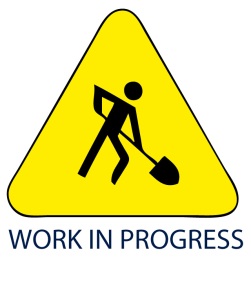 “It’s for Sale, so It Must Be Finished: Digital Projects in the Scholarly Publishing World” by David Sewell poses a how-long-is-a-piece-of-string type question in relation to a digital work’s finality. Having read this article, I think it is apparent there is no simple or easily obtained answer. However, to complicate the matter even further, the answer is dependent upon how we define the criteria for “done-ness” (Sewell unpaginated).
“It’s for Sale, so It Must Be Finished: Digital Projects in the Scholarly Publishing World” by David Sewell poses a how-long-is-a-piece-of-string type question in relation to a digital work’s finality. Having read this article, I think it is apparent there is no simple or easily obtained answer. However, to complicate the matter even further, the answer is dependent upon how we define the criteria for “done-ness” (Sewell unpaginated).  How can we say a digital work is complete, if it cannot be confined to the print publication boundaries of a beginning or ending? How can a digital work ever be considered finished if the cut-off point is unknown, unforeseeable and possibly intangible? Or maybe the finished-unfinished dichotomy is not applicable to certain kinds of texts. Because we can categorise printed works and some digital works into either side of this dichotomy, does it necessarily mean that everything should automatically qualify as done or unfinished?
How can we say a digital work is complete, if it cannot be confined to the print publication boundaries of a beginning or ending? How can a digital work ever be considered finished if the cut-off point is unknown, unforeseeable and possibly intangible? Or maybe the finished-unfinished dichotomy is not applicable to certain kinds of texts. Because we can categorise printed works and some digital works into either side of this dichotomy, does it necessarily mean that everything should automatically qualify as done or unfinished?
Sewell claims that one consequence of the aforementioned insurmountable quandary is that it postponed “the entrance of digital scholarship into the traditional system of peer-reviewed academic publication” (Sewell unpaginated). I think this is understandable from the juxtaposition Sewell makes between digital and traditional print publication. When a book or journal is regarded as complete the knee-jerk assumption is that it has gone through the scrutinising process of editing, proof-reading, review and revision.
While on the other hand, the assertion that “a digital project or publication is “done” may be met with suspicion” (Sewell unpaginated). I think this suspicion and xenophobic reaction is justifiable to a certain degree when  we consider digital publication, unlike print publication, is in an unstable or inconstant state. A digital publication can be altered by up-dates and add-ons instantaneously with the touch of a button, while print publication could only achieve this with the drawn-out process of releasing a revised edition.
we consider digital publication, unlike print publication, is in an unstable or inconstant state. A digital publication can be altered by up-dates and add-ons instantaneously with the touch of a button, while print publication could only achieve this with the drawn-out process of releasing a revised edition.
With that in mind, our conventional definition of a text is now under threat. Landow remarks a text is “no longer a finished corpus of writing” (qtd. in Sewell). If it cannot be considered finished in the same way as the front-and-back concept of print publication, then where can we draw the line? Sewell proposes, from a socioeconomic perspective, that a digital work “is “done” when the Press is prepared to offer it for purchase and customers are prepared to buy it” (Sewell unpaginated). Of course, this is provided that customers are willing to neglect the returns policy on unfinished goods which would certainly raise eyebrows if it caught on with print publication. If Dan Brown wrote an incomplete novel, I doubt it would go down too well with the critics or even make its way to the shelves of Waterstones for that matter. Our distasteful reaction to an incomplete book, unless it is due to uncontrollable circumstances like the death of the author, originates from the expectation of finitude that goes hand in glove with print publication. However, these expectations or presumptions must not cross contaminate from print into the digital realm. Some digital works simply cannot and more than likely will never obtain the status of completion. Instead they will be perpetually in a state of work-in-progress like Wikipedia, and possibly Byrant’s “fluid-text” edition of Herman Melville’s Typee.
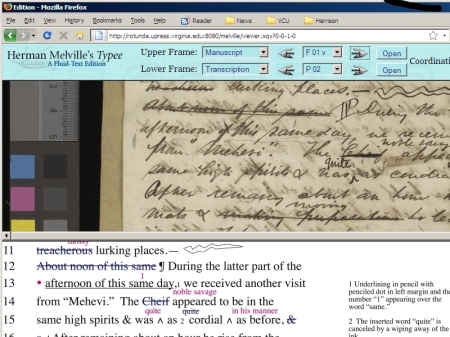 Sewell notes that “a fluid-text edition needs to capture a dynamic process” (unpaginated). Prior to the first edition of Typee, a plethora of alterations were made to the text by Melville himself and his publisher. Byrant’s main objective was to apprehend this textual dynamism and permit the reader to witness the invisible evolution of the authorial composition and editorial contribution to the narrative construction of the text.
Sewell notes that “a fluid-text edition needs to capture a dynamic process” (unpaginated). Prior to the first edition of Typee, a plethora of alterations were made to the text by Melville himself and his publisher. Byrant’s main objective was to apprehend this textual dynamism and permit the reader to witness the invisible evolution of the authorial composition and editorial contribution to the narrative construction of the text.
Byrant states in his introductory essay “Herman Melville’s Typee: ‘Editing a Fluid Text’” that “[t]he goal of fluid-text editing is to make such invisible texts visible” (Byrant unpaginated) to the reader. As we are all well aware, literary works usually do not come in a single version, but in “multiple versions”. Byrant labels these multi-versioned texts as “fluid-text[s]” (Byrant unpaginated) because every version of the text portrays “a revision process triggered, in some moment of intentionality, by the individual writer, or through a collaboration of writers and editors, or because of pressures by certain reader groups” (Byrant unpaginated). All these contributing factors have occurred unbeknownst to the reader who is only allowed the privilege of consuming the end product of a text. However, once having read (or viewed in the case of a film) an alternative version of a text, our comprehension of it as “fixed and invariant” (Byrant unpaginated) is transformed to a realisation of its fluidity.
 I think the reasons for the availability of alternative versions of a text are just as captivating as the multiple texts themselves. An editor of Herman Meville’s Typee faces the difficulty of interpreting the revisions Meville has made to the text. Although one could argue that editors do not have the authority to alter a text, but the reality is editors may be left with no other option. For example, “Melville writes: “the putrefying relics of some blo recent sacrifice” in Typee. Having read this and contemplated the meaning of ‘blo’, it is fair to say that one would not be committing a mortal sin by suggesting that the word Melville intended was possibly “bloody”. However, if we consider the actual context of the sentence then we soon realise our error of judgement. Byrant notes “that Melville momentarily intended to recast the Typeean sacrifices as human (or at least animal) rather than just vegetal but that he changed his mind in mid-revision” (Byrant unpaginated). This example demonstrates an editor’s responsibility for critically judging the possible interpretations of a text.
I think the reasons for the availability of alternative versions of a text are just as captivating as the multiple texts themselves. An editor of Herman Meville’s Typee faces the difficulty of interpreting the revisions Meville has made to the text. Although one could argue that editors do not have the authority to alter a text, but the reality is editors may be left with no other option. For example, “Melville writes: “the putrefying relics of some blo recent sacrifice” in Typee. Having read this and contemplated the meaning of ‘blo’, it is fair to say that one would not be committing a mortal sin by suggesting that the word Melville intended was possibly “bloody”. However, if we consider the actual context of the sentence then we soon realise our error of judgement. Byrant notes “that Melville momentarily intended to recast the Typeean sacrifices as human (or at least animal) rather than just vegetal but that he changed his mind in mid-revision” (Byrant unpaginated). This example demonstrates an editor’s responsibility for critically judging the possible interpretations of a text.
 Needless to say, it is not just editors who donate to the amendment of a text. Publishers and printers have also been caught with their hand in the cookie jar which further muddies the water. The extent of a publisher’s influence on a text, most memorable to me, is apparent from the Anglo-Irish Gothic novel, Melmoth the Wanderer, by Charles Robert Maturin. The structure of the novel resembles a set of Russian dolls because within each section is a story within another story. However, it has been revealed from written communications between Maturin and his publisher, Archibald Constable, that the publisher was largely responsible for the intricate structure of the novel. The significance of this revelation not only undermines our appreciation of the novel, but it also alters our translation of Maturin’s intentions and our reading of the text. If this evidence was not presented to the reader, the entire process of collaboration between author and publisher would remain invisible to the reader.
Needless to say, it is not just editors who donate to the amendment of a text. Publishers and printers have also been caught with their hand in the cookie jar which further muddies the water. The extent of a publisher’s influence on a text, most memorable to me, is apparent from the Anglo-Irish Gothic novel, Melmoth the Wanderer, by Charles Robert Maturin. The structure of the novel resembles a set of Russian dolls because within each section is a story within another story. However, it has been revealed from written communications between Maturin and his publisher, Archibald Constable, that the publisher was largely responsible for the intricate structure of the novel. The significance of this revelation not only undermines our appreciation of the novel, but it also alters our translation of Maturin’s intentions and our reading of the text. If this evidence was not presented to the reader, the entire process of collaboration between author and publisher would remain invisible to the reader.
However, Byrant’s Typee website overcomes this dilemma by highlighting the invisible alterations of the texts by providing side-by-side manuscript and narrative translations. Byrant proposes that “[e]ditors must invite readers to become editors or to think editorially, as they read, and thus become attuned to the pleasures of the fluid text” (Byrant unpaginated).
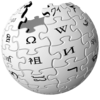
Missing pieces?
Furthermore, Sewell refers to Wikipedia in his essay, as an example of an incomplete digital publication because it is a continuous work-in-progress. However, the million dollar question is does a work require a finished status in order to be accepted as qualitative? Maybe we need to examine the dilemma of “done-ness” from an alternative perspective in order to formulate a plausible answer. Perhaps as a society we should abandon our apeirophobia and reconsider our obsessive need for finitude. Maybe we need to shift our focus from quantity to quality which Wikipedia has begun to do. Wikipedia is now looking backward instead of forward in order to clean up the trail of rubbish articles that they left behind when rushing forward to the elusive finish line. This mentality begs the question: why should there be a struggle for completion at the expense of quality especially when Wikipedia has no apparent deadline in the first place?
 Let’s hypothetically suggest that Wikipedia will achieve completion in approximately 100 years’ time. Undoubtedly, by that time a lot will have changed. Technology, society, and even language to name but a few things will have altered so much so that the previously completed articles would have to be rewritten. Thus taking another uncertain number of years to complete and do I need to say anymore? I think that with a case like this it is not only unbefitting but also ludicrous to attempt to situate Wikipedia and “done” in the same sentence. I accept that some may argue that there cannot be that many more articles left to write so therefore Wikipedia must be somewhere near completion. However, this myopic attitude doesn’t take into consideration the effort that is being expended on maintaining the articles that already exist which are under a constant threat of vandalism and scrutiny from cyber-vandals and anti-wikipedians. If we couple that with the time it will take to cover the articles that have not yet been written then they have a long road to travel, but unfortunately once they reach their destination they have to turn back and start all over again. Consequently, the Herculean task Wikipedia has undertaken for the long haul appears to be a Sisyphean struggle which only the future will tell if it was worth the hassle. However, if the advancements since its appearance in 2001 are anything to go by, the future of Wikipedia will be very prosperous indeed even if its status will remain as work-in-progress.
Let’s hypothetically suggest that Wikipedia will achieve completion in approximately 100 years’ time. Undoubtedly, by that time a lot will have changed. Technology, society, and even language to name but a few things will have altered so much so that the previously completed articles would have to be rewritten. Thus taking another uncertain number of years to complete and do I need to say anymore? I think that with a case like this it is not only unbefitting but also ludicrous to attempt to situate Wikipedia and “done” in the same sentence. I accept that some may argue that there cannot be that many more articles left to write so therefore Wikipedia must be somewhere near completion. However, this myopic attitude doesn’t take into consideration the effort that is being expended on maintaining the articles that already exist which are under a constant threat of vandalism and scrutiny from cyber-vandals and anti-wikipedians. If we couple that with the time it will take to cover the articles that have not yet been written then they have a long road to travel, but unfortunately once they reach their destination they have to turn back and start all over again. Consequently, the Herculean task Wikipedia has undertaken for the long haul appears to be a Sisyphean struggle which only the future will tell if it was worth the hassle. However, if the advancements since its appearance in 2001 are anything to go by, the future of Wikipedia will be very prosperous indeed even if its status will remain as work-in-progress.








 “Multimedia and Multitasking: A Survey of Digital Resources for Nineteenth-Century Literary Studies” by John A. Walsh is a meet-the-parents moment for the digital scholar. Walsh acquaints his reader with the “parents of the digital age” (Walsh unpaginated); the nineteenth century and the industrial Revolution. He believes the nineteenth century “holds a special attraction for digital literary scholarship” (unpaginated) because of the parallels and similarities shared between the two eras’ proximate chronology. Like the digital revolution, the industrial revolution effectuated “rapid technological and social change” (unpaginated), resulting in a boom of information, and technologies to communicate that information.
“Multimedia and Multitasking: A Survey of Digital Resources for Nineteenth-Century Literary Studies” by John A. Walsh is a meet-the-parents moment for the digital scholar. Walsh acquaints his reader with the “parents of the digital age” (Walsh unpaginated); the nineteenth century and the industrial Revolution. He believes the nineteenth century “holds a special attraction for digital literary scholarship” (unpaginated) because of the parallels and similarities shared between the two eras’ proximate chronology. Like the digital revolution, the industrial revolution effectuated “rapid technological and social change” (unpaginated), resulting in a boom of information, and technologies to communicate that information. “ePhilology: When the Books Talk to Their Readers”, by Crane, Bamman, and Jones, explores the evolutionary direction ePhilology may take in the digital humanities. For those, like me, who fall under the category of neophyte, Philology can be loosely defined as the study of literary texts and of written records.
“ePhilology: When the Books Talk to Their Readers”, by Crane, Bamman, and Jones, explores the evolutionary direction ePhilology may take in the digital humanities. For those, like me, who fall under the category of neophyte, Philology can be loosely defined as the study of literary texts and of written records.
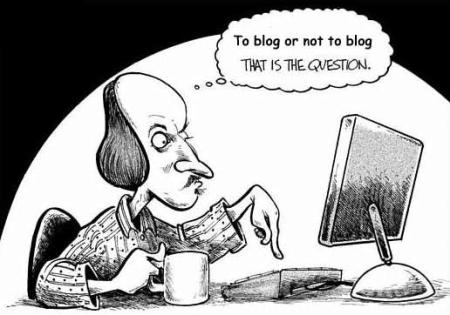
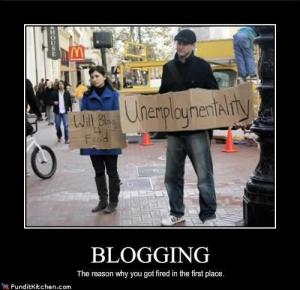
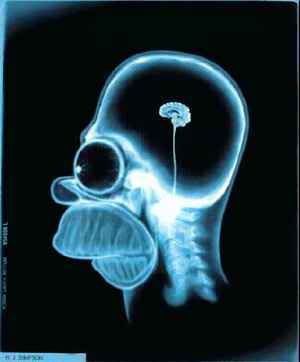 As I read Alan Liu’s essay
As I read Alan Liu’s essay 


